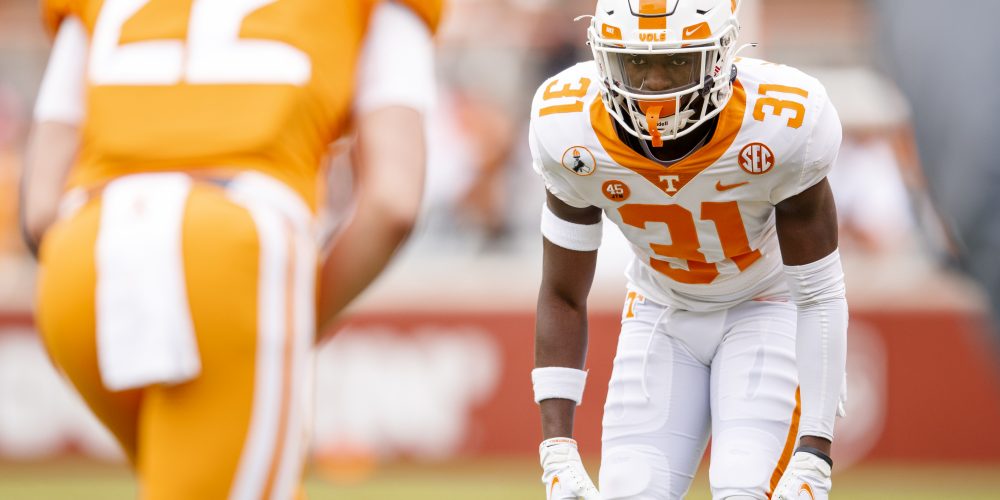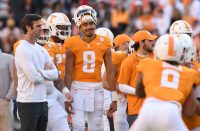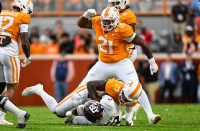Every offseason, we run a series on where Tennessee can make the most improvement. It’s a good way to examine how the Vols might get better, fastest. And for all the pendulum swing of Jeremy Pruitt to Josh Heupel, the place Tennessee has the most room for improvement from last year is on the defensive side of the ball.
A million years ago, #3 Tennessee played #2 Nebraska in the Orange Bowl. It was Peyton Manning’s final game, and even though a win by #1 Michigan in the Rose Bowl the day before had eliminated the Vols from the national title picture, there was still hope an elite 1997 Vol squad could end the season with a huge win over the Cornhuskers. Instead, those Vols succumbed to the Thanos-like inevitability of Nebraska’s triple option: 68 carries for 409 yards, a 14-3 halftime hole quickly becoming a 42-17 beat down. In the third quarter, Nebraska had three touchdown drives of 70+ yards that I’m not sure included any passing plays.
If they had, it would’ve been Scott Frost pulling the trigger. A lifetime later, Frost left Central Florida to return to the alma mater, paving the way for Josh Heupel to get his first head coaching gig and come to Knoxville three years later. College football has changed quite a bit from 1997 to 2021. But the inevitability of another team coming down the field on us was all too familiar last fall.
In 2020, Tennessee’s defense allowed opposing quarterbacks to complete 68.2% of their passes, 125th of 127 teams playing last fall. This is where the Vols have the most room for improvement in 2021.
As the game has evolved, completion percentage is slightly on the rise around the country. In conference play, the national median completion percentage was between 58-59% from 2013-17. The last three years, it’s climbed to 59.4%, 60.6%, and 61.4% last fall. (Stats via SportSource Analytics)
Tennessee’s struggle in this department, somewhat surprisingly, can be traced directly to Pruitt’s defenses. Between Phillip Fulmer’s exit in 2008 and Jeremy Pruitt’s arrival in 2018, Vol defenses allowed opposing quarterbacks to complete 60+ percent of their passes in just two seasons: a depth-depleted group in 2011 (60.9%), and Sal Sunseri’s infamous unit the following year (65.3%). Tennessee was actually pretty good in this department under John Jancek, finishing 15th nationally in completion percentage allowed in conference play in 2014, and ninth in 2015.
But the last three years, Tennessee’s defense has struggled mightily to disrupt opposing passing games: 67.5% allowed in 2018, 61.9% in 2019, and 68.2% last year (again, all numbers in conference play for the apples-to-apples comparison with last fall).
In the last 12 seasons, opposing quarterbacks completed 70+% of their passes against the Vol defense on at least 25 attempts 13 times. Four of those 13 happened last season, and the three highest completion percentages allowed all happened in the last two seasons:
| Year | Opponent | Primary QB | CMP | ATT | PCT |
| 2019 | Georgia | Jake Fromm | 24 | 29 | 82.8% |
| 2020 | Texas A&M | Kellen Mond | 26 | 32 | 81.3% |
| 2020 | Alabama | Mac Jones | 28 | 36 | 77.8% |
| 2015 | Alabama | Jake Coker | 21 | 27 | 77.8% |
| 2013 | Vanderbilt | ACS/Robinette | 24 | 31 | 77.4% |
| 2012 | Georgia | Aaron Murray | 20 | 26 | 76.9% |
| 2018 | West Virginia | Will Grier | 25 | 34 | 73.5% |
| 2020 | Arkansas | Felipe Franks | 18 | 25 | 72.0% |
| 2020 | Florida | Kyle Trask | 35 | 49 | 71.4% |
| 2016 | Virginia Tech | Jerod Evans | 20 | 28 | 71.4% |
| 2013 | Oregon | Marcus Mariota | 25 | 35 | 71.4% |
| 2019 | Florida | Kyle Trask | 24 | 34 | 70.6% |
| 2018 | Missouri | Drew Lock | 21 | 30 | 70.0% |
No matter how good Tennessee’s offense could’ve been or would’ve been if the quarterback position had been settled, and no matter how good the Vol defense could be against the run – 27th nationally in yards per carry allowed in conference play! – when teams can routinely drop back and get whatever they want through the air, there is indeed an inevitability to the end result. On third-and-short (1-3 yards) last season, the Vol defense allowed 16-of-18 (88.9%) for 13 first downs through the air. On third-and-medium (4-6 yards), it was 17-of-25 (68%) for 16 first downs.
Tennessee obviously needs to impact the opponent passing game in far greater ways. But the Vols were actually fairly average in getting to the quarterback: 20 sacks over 10 conference games, 67th nationally in sacks per game. Texas A&M is the only game where the defense failed to record a single sack, and they got Felipe Franks four times, despite his 72% completion percentage. So while the Vols can certainly aspire to be more than average in getting the QB, it’s not where the most improvement can be done.
The inevitability of last season certainly felt worst watching teams run routes over the middle of the field. And this is where the struggle may still be quite real, as the Vols are scrambling at linebacker on the depth chart. But whether third-and-short or third-and-medium, you could get what you wanted far more often than not against Tennessee’s coverage last fall. Tim Banks and the Vols will need to scheme it better than Pruitt’s defenses did for three years to improve completion percentage rates. But they’ll also need bodies to run those schemes; it’s a big opportunity and a big task for whoever can get healthy, learn the system, and translate it to something productive in disrupting the passing game.
The good news is, this is where the most improvement can be made. And for fan and team morale, anything better than the inevitability of a completed pass is going to look and feel very much like progress.





Something that looks competent will be an improvement. If we can disrupt passers and get takeaways, I think we’ll be okay. It’s what Heupel’s defenses are charged with. They don’t have to stop every drive. They just need to get the ball back for their offense with short fields a couple of times a game.
2 things…
Yeah, a good Virginia Tech team putting the ball on the ground six times makes that Bristol game an outlier on just about any list. Obligatory shout out to the weirdness of 2013 Vanderbilt on that list too.